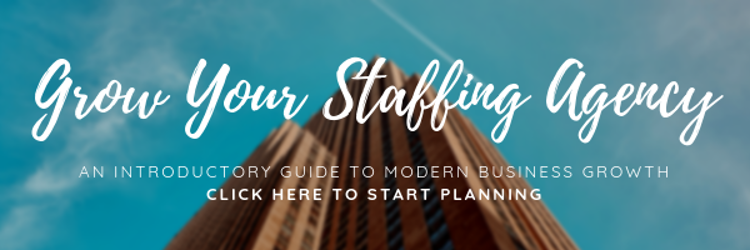It's time to g(r)o(w). Your staffing agency is stuck.
You're doing well enough, you suppose... your messaging is resonating with your customers. Attrition is low, and satisfaction is high.
But you're not growing... at least, you're not growing as fast as you'd like, and you're looking for ways to fill the gap between your goals and reality.
Inbound marketing might be the answer, and it is something you can implement right now... It works in parallel with your existing sales and marketing plans, so it won't turn your world upside down. Additionally, it follows a proven formula. It's also typically cheaper and easier to accomplish through a turn-key agency.
So, it won't tax your existing resources, require anybody to learn a new process, or disrupt your existing ecosystem.
If anything, it's going to be a relief.
If your growth gap is more than $500,000, this could be exactly what you need.
Why inbound?
Go to your top salesperson, and ask them the question, "how would you feel about receiving 4 or 5 inbound leads every day?" See how they react.
If they (or you) are curious about what a true inbound lead is, show them this. I'm not talking about the "contact us" form tire-kickers. I'm talking about actively engaged prospects with real buying potential.
Inbound means that your leads are coming to you. They give your company permission to market and sell to them in exchange for something... entrance to a webinar, ownership of a downloadable content offer, access to a forum... or even yes, a "contact us" form.
Considerably more often than outbound leads, they're engaged to your company AND the solutions it provides.
Inbound also helps boost outbound activities. If your folks are cold-calling, for example, they can leverage inbound content to spark conversations. They're less salesy this way, and much more consultative. When the prospect interacts with the content, they become even more engaged and likely to buy.
NOTE: There has to be a demand for your services or products in order for this to work. And there has to be a knowledge-base around market saturation and general product or service viability.
Start-ups still seeking market validation can use this formula to test the waters. It will give you a lot of great data, but it may not generate actual results if there are issues with the product, pricing, positioning, sales process, or your general knowledge of the market.
Learn how to scale your staffing business with this free guide:
The inbound formula:
Traffic > Leads > Customers > Retention
Seems simple enough. Now, let me break it down into actual numbers that relate to your scaling goals. For the purposes of this article, I'm going to focus on customer acquisition. Retention is an entirely different beast, so I'll tackle it at another time.
That means we'll drop "retention" for today's intents and purposes:
Traffic > Leads > Customers
In order to help you with yours, we're going to work backwards. The best way to follow along is to grab a copy of our free Marketing Objectives Calculator, and fill out the cells as I go through them with you in this article.
First, we have to understand what's under the hood:
- What's your average monthly traffic? (without paid ads)
- Average number of leads coming from your website every month?
- Average number of customers generated through website leads?
- Average non-recurring sales price
- Average recurring sales price per month
- Recurring vs individual sales ratio
Next, we need to know your goals:
- How much are you trying to grow by? 5%? 20%?
- What does that equate to in revenue?
- How many customers do you need to close per month in order to hit those goals? (don't forget about attrition)
- How many leads do you need to generate per month in order to hit those customer goals?
Timing:
Everything involved here has a learning phase, prep phase, and execution. Since you're making an investment, I expect you'll want to know when to see a return.
Launch:
An inbound launch should take 2 months. Some folks will spend 2 months building out a strategy first, because it gives them a chance to gather data while getting some hands-on research going. If you have NO data whatsoever, that may be the better place to start. A website launch also takes 2 months. Again though, with the same caveats as inbound.
By the way, launching inbound and a website together can reduce costs in some cases.
A typical launch entails:
- Technical setup and integrations
- Foundation knowledge development of your product/service
- Research (competition, market, personas, marketing performance data, etc)
- Developing over-arching and tactical execution strategies
- Developing first round of content (offer, blog posts, emails, etc)
- Developing rules of engagement internally & externally
- Developing PPC ad strategy and ad content
Learning:
The post-launch learning period is 2 - 3 months, similar to a pre-launch period. You take it week-by-week, then month-by-month, testing ads against inbound, looking at the data, and making adjustments where appropriate. By Month 3 or 4 your program should hit its stride. From there we make incremental month-over-month progress by publishing more blog posts and content offers.
Reward:
Month 1 might generate a single Marketing Qualified Lead (MQL) but 10 leads. Month 2 might double or triple that... But you want to work your way toward an inbound minimum standard of converting at least 1% of your website visitors into leads. Once there, set your sites on 2, then 3%, which is possible if your content is doing what it's supposed to do. In some cases, 5% is doable.
You accomplish this by generating more content offers and more blogs. There are different personas that you should be targeting as well as different stages of the buyer's journey. When the more diverse those offers are, the higher that conversion rate will climb. By month 12, a 2 - 3% conversion ratio is a reasonable, conservative target.
Ever wonder what your competition is doing to try and beat you?
Calculating your goals
Below you will find a graphic ripped straight from our marketing objectives calculator. This is how you compartmentalize the milestones for your marketing investments and lay out benchmark metrics.
Step 1: Set your basis

Above you will find the metrics from a software as a service client (SaaS) with a moderately aggressive growth plan of $10,000,000 by the end of year 2. They had roughly 2,000 visitors per month, but generated next to nothing with respect to customers. Currently, their customers are coming from cold calling, networking, and referrals. And, their average monthly recurring sale price is $2,000. Lastly, their retention rate is well over 2 years.
Step 2: Establish your marketing targets

This is where we start playing with the numbers. For this particular example, the company is already converting 1% of its visitors, albeit, none are turning into customers. But that conversion rate is something we can directly influence through inbound marketing.
By creating content offers for the varying stages of the buyer's journey and target personas, you will improve those numbers. Granted, the content has to have value... it's typically not enough to publish your fliers or brochures in this manner.
A big key here is to gate those offers. For more information about the inbound conversion mechanisms, check out this article.
We can also influence customer conversion rates through inbound.
- By bringing in better leads
- By integrating inbound with sales
- By cross-collaborating between departments
- By coaching through the inbound sales process
A reasonable visitors-to-lead conversion rate for inbound is 2 - 5%. A reasonable lead-to-customer conversion rate is 2 - 10%.
Start conservative, and realize that you will go through a learning curve. Also, your most rapid growth in these areas will likely occur in year 1 as long as you have an aggressive enough content strategy.
NOTE: This data is a starting point. It makes a lot of bold assumptions that likely aren't true. On the next tab, we'll look at where you can make adjustments in order to back into your goals.
Step 3: Refine your targets

The next tab is all about refining and amortizing. The yellow boxes are blank when you open it. These are the numbers your marketing investment and sales efforts will directly influence, and what is ultimately under your control.
If you notice, there is a steep traffic requirement of 34,000 visitors per month in order to reach this revenue goal. Because of this, a significant investment in PPC needs to be made. We won't know the cost per click from this vantage point, but you may based on your existing campaigns.
NOTE: This is based off of a 90-day average sales cycle. Leads generated in month 1 will close in month 4 at the rate of month 1. If you're already closing deals from leads coming out of your website, expect a faster ramp-up. If you want something customized to your sales cycle time, schedule a time to speak with one of our assessment specialists, and they'll do exactly that.
Now, let's look at year 2:

Notice how we came pretty darned close to $10,000,000 in growth in this initial pass. This is where we can start manipulating numbers. Maybe you throw in some PR traffic... or increase PPC ad spend... or work on ways to improve the sales close #s.
At least now, you have a system in place that puts the $10,000,000 growth mark within striking distance.
Step 4: Measure ROI

This is your last functional tab of the calculator. Here, you input your sales costs and cost of goods sold. If you have no marketing investments, and you need to get a handle on pricing, schedule a free assessment, and we'll narrow in on those for you.
Based on this particular projection, year 2 should enter into profitability relatively quickly.
CONCLUSION:
Now that you've seen the formula, what do you think? Does inbound seem like the right step for your company? Is it helpful in helping you understand how to scale a business using inbound?
I should warn you... Inbound is not the only thing you're going to need. Scaling a staffing agency, a SALES organization, takes more than more leads... it takes a serious commitment to sales support
Click HERE to learn more about how we can help your staffing agency grow using inbound marketing and sales enablement:




